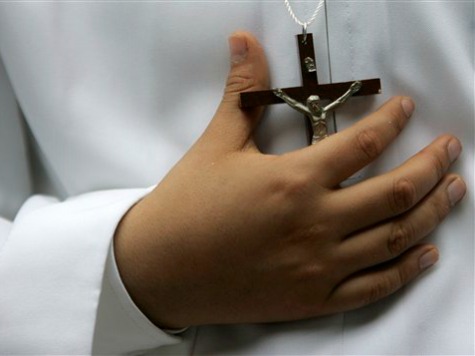The mayor of the northern Italian city of Padua announced on Wednesday that all public buildings must display a crucifix.
Massimo Bitonci, a member of the anti-EU, anti-immigration Lega Nord, made the announcement on his Facebook page: “Now every office and every school will get a nice mandatory crucifix donated by the city. Hands off the crucifixes or you will be in trouble.” He also posted a picture of himself holding a crucifix.
According to Ansa, an Italian news service, the picture was taken at a 2009 sit-in when Bitonci was distributing free crucifixes in the nearby town of Abano Terme, where in 2002 a public school refused to comply with a request by Soile Lautsi, a citizen of Finland and of Italy, who had two sons at the school. Lautsi wanted the religious symbol removed from the classroom.
Lautsi took a case against the school council and lost, then pursued her fight through several appeals in Italian courts until she finally lost in 2011 at the European Court of Human Rights (ECHR), the court of the 47-member Council of Europe.
The ECHR ruled that displaying a crucifix is not itself sufficient “to denote a process of indoctrination” and “a crucifix on a wall is an essentially passive symbol” which “cannot be deemed to have an influence on pupils.”
Since then, Padua has been the centre of the continuing debate over crucifixes. Reaction to Bitonci’s order on crucifixes in all public buildings was welcomed by some. The Local reported that one Facebook user wrote: “Great Bitonci, everyone should be like you,” but another disagreed and said: “Italy is a secular country! Whoever wants to impose a religious simple is disrespectful of others and should be stopped! Bitonci, feel ashamed!”
Italy’s 1948 constitution says it is a secular state and that all religions are equal before the law. However, according to Ansa, “the government never explicitly abrogated decrees making crucifixes mandatory dating from the preceding Fascist regime. As a result many hospitals, courts and schools still display the Catholic symbol.”
In fact, the crucifix is a symbol used by many different groups of Christians, not just Roman Catholics. The crucifix represents the body of Christ on the cross, as distinct from the bare cross, favoured by some Protestant churches.

COMMENTS
Please let us know if you're having issues with commenting.